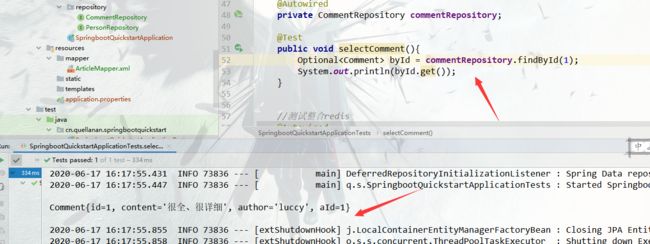springboot 整合 Mybatis、JPA、Redis
引言
在springboot 项目中,我们是用ORM 框架来操作数据库变的非常方便。下面我们分别整合mysql ,spring data jpa 以及redis 。让我们感受下快车道。
我们首先创建一个springboot 项目,创建好之后,我们来一步步的实践。
使用mybatis
引入依赖:
org.mybatis.spring.boot
mybatis-spring-boot-starter
2.1.1
增加配置
application.properties 中增加连接数据库的配置。
# Mysql数据库连接配置 : com.mysql.cj.jdbc.Driver
spring.datasource.url=jdbc:mysql://localhost:3306/mybatis?serverTimezone=UTC&characterEncoding=utf8&useUnicode=true&useSSL=false
spring.datasource.username=root
spring.datasource.password=123456
创建sql
接下来,我们创建sql 语句。方便我们后面测试吧。
# 创建数据库
CREATE DATABASE springbootdata;
# 选择使用数据库
USE springbootdata;
# 创建表t_article并插入相关数据
DROP TABLE IF EXISTS t_article;
CREATE TABLE t_article (
id int(20) NOT NULL AUTO_INCREMENT COMMENT '文章id',
title varchar(200) DEFAULT NULL COMMENT '文章标题',
content longtext COMMENT '文章内容',
PRIMARY KEY (id)
) ENGINE=InnoDB AUTO_INCREMENT=2 DEFAULT CHARSET=utf8;
INSERT INTO t_article VALUES ('1', 'Spring Boot基础入门', '从入门到精通讲解...');
INSERT INTO t_article VALUES ('2', 'Spring Cloud基础入门', '从入门到精通讲解...');
# 创建表t_comment并插入相关数据
DROP TABLE IF EXISTS t_comment;
CREATE TABLE t_comment (
id int(20) NOT NULL AUTO_INCREMENT COMMENT '评论id',
content longtext COMMENT '评论内容',
author varchar(200) DEFAULT NULL COMMENT '评论作者',
a_id int(20) DEFAULT NULL COMMENT '关联的文章id',
PRIMARY KEY (id)
) ENGINE=InnoDB AUTO_INCREMENT=3 DEFAULT CHARSET=utf8;
INSERT INTO t_comment VALUES ('1', '很全、很详细', 'luccy', '1');
INSERT INTO t_comment VALUES ('2', '赞一个', 'tom', '1');
INSERT INTO t_comment VALUES ('3', '很详细', 'eric', '1');
INSERT INTO t_comment VALUES ('4', '很好,非常详细', '张三', '1');
INSERT INTO t_comment VALUES ('5', '很不错', '李四', '2');
创建实体
再接下来,我们需要创建 一个实体类,我们就创建一个 t_comment 表对应的实体类吧。
public class Comment {
private Integer id; //评论id
private String content; //评论内容
private String author; //评论作者
private Integer aId; //外键:表示当前这条评论是属于那篇文章
//getter()/setter()
创建mapper
上面都做好后,我们当然是来创建一个mapper 接口,来操作数据库啦,这里我们来一个最简单的,使用注解的方式。
//标识该接口是mybatis的接口文件,并且让springboot能够扫描到该接口,生成该接口的代理对象,存到容器中
@Mapper
public interface CommentMapper {
//根据id查询对应评论信息
@Select("select * from t_comment where id = #{id}")
Comment findById(Integer id);
}
创建测试
上面这样其实就已经完成了springboot 与mybatis 的整合,我们接下来测试一下。
在pom.xml 文件中引入:
org.springframework.boot
spring-boot-starter-test
test
junit
junit
test
org.junit.platform
junit-platform-launcher
test
在测试类中编写:
@RunWith(SpringRunner.class)
@SpringBootTest
class SpringbootQuickstartApplicationTests {
@Autowired
private CommentMapper commentMapper;
@Test
void contextLoads() {
Comment comment = commentMapper.findById(1);
System.out.println(comment);
}
}
效果:

证明整合mybatis 是成功的。是不是很简单,只用引入一个starter 就可以正常使用mybatis 的功能。
基于xml 方式
上面的是基于注解的,我们也可以基于xml。我们在mapper 中不写sql ,而放到xml 中编写。这里 ArticleMapper 为例
@Mapper
public interface ArticleMapper {
//根据id查询对应的文章
public Article selectArticle(Integer id);
}
对应的xml 文件:
这里我们需要在配置文件中指定我们mapper.xml 的位置,如果不指定,就需要和mapper 同目录才行。resultType 可以在配置文件中指定别名。
#开启驼峰命名匹配映射mapper
mybatis.configuration.map-underscore-to-camel-case=true
#配置mybatis的xml映射配置文件路径
mybatis.mapper-locations=classpath:mapper/*.xml
#配置mybatis映射配置文件中实体类别名
mybatis.type-aliases-package=cn.quellanan.springbootquickstart.pojo
我们再写个测试方法测试下。
@Autowired
private ArticleMapper articleMapper;
@Test
public void selectArticle(){
Article article = articleMapper.selectArticle(1);
System.out.println(article);
}
这样springboot 整合mybatis 基本的就ok 啦。
使用jpa
上面我们springboot整个mybatis 需要自己写sql ,接下来我们偷偷懒,整合一下springData JPA。之前说过,springboot data jpa 是一种规范,必须使用实现这种规范的框架,所以前面用了 hibernate 。但是在springboot 中就不用这么麻烦啦,也不用引入 hibernate 相关的jar .我们也可以使用。下面我们来看看。
引入依赖
第一步还是需要在pom 文件中引入依赖。
org.springframework.boot
spring-boot-starter-data-jpa
建立实体类和表的关系
引入依赖后,我们需要将实体类和表以及表属性建立联系。我们还是以 Comment 这个类。进行修改。
@Entity
@Table(name = "t_comment")
public class Comment {
@Id //表明映射主键id
@GeneratedValue(strategy = GenerationType.IDENTITY)
private Integer id; //评论id
private String content; //评论内容
private String author; //评论作者
@Column(name = "a_id")
private Integer aId; //外键:表示当前这条评论是属于那篇文章
//getter()/setter()
}
- 首先需要 @Entity 标识这个实体类,可以被处理
- @Table() 注解指定数据库对应的表名
- @Id 用来指定表的主键。
- @GeneratedValue() 用来指定主键的类型
- @Column 用来指定这个属性对应的表的列名,如果类属性和表列名一致可不指定,不一致就需要指定。
创建一个接口
我们接下来创建一个接口来使用它,继承JpaRepository 。有两个参数,第一个参数是是对应的实体类对象,第二个参数主键数据类型。
public interface CommentRepository extends JpaRepository {
}
测试
接下来,我们就可以进行测试啦
@Autowired
private CommentRepository commentRepository;
@Test
public void selectComment(){
Optional byId = commentRepository.findById(1);
System.out.println(byId.get());
}
所以如果不想使用mybatis ,那springboot 整合jpa 也是一种不错的选择。
使用redis
上面不管是mybatis 还是 springdatajpa 都是基于关系型数据库操作的,我们上面操作的就是mysql 数据库。现在redis 也经常在项目中使用,那springboot 整合使用redis 也很方便。
引入依赖
一样的,我们首先需要引入依赖。
org.springframework.boot
spring-boot-starter-data-redis
配置redis 连接信息
在application.propertis 中增加redis 的相关配置
#redis服务器地址
spring.redis.host=127.0.0.1
#redis服务器连接端口
spring.redis.port=6379
#redis服务器连接密码
spring.redis.password=
其实到现在,我们就已经整合好了,可以在项目中操作redis 数据库啦。
我们来写一个测试方法,分别是插入和查找。
@Autowired
private StringRedisTemplate redisTemplate;
@Test
public void insert(){
redisTemplate.opsForValue().set("quellanan","程序员爱酸奶");
}
@Test
public void select(){
String quellanan = redisTemplate.opsForValue().get("quellanan");
System.out.println(quellanan);
}

可以看到我们直接用的 StringRedisTemplate 。这个就相当于 JdbcTemplate 操作数据库一样。兄弟们现在明白了吧,相当于是没有使用mybatis 或者jpa 这些框架,而是简单粗暴的操作数据库了。
现在很多公司使用数据库也是直接使用 StringRedisTemplate 或者 RedisTemplate 来操作的redis 的数据库的,因为基于redis 的持久层框架还不流行。当然我们也可以使用,接下来我们来点骚的。
创建一个实体类。
@RedisHash(value = "persons") //指定实体类对象在redis中的存储空间
public class Person {
@Id // 用来标识实体类主键 字符串形式的hashkey标识唯一的实体类对象id
private String id;
@Indexed // 用来标识对应属性在redis中生成二级索引
private String firstname;
@Indexed
private String lastname;
private Address address;
}
- @RedisHash 用来指定类的储存类型,这里使用的的是RedisHash 表示在数据库中使用hash 存储。值得注意的是只有@RedisHash 这个注解来作用于实体类上,这个persons 更像是文件夹,key 的前缀。
- @Id 表明主键,其实就是redis 中hash 结构的和前缀组成 key
- @Indexed,用来标识redis 数据库生成二级索引,方便条件查询,一样的和前缀以及属性名组成key。
创建一个接口。
这里继承的是CrudRepository 。并且也是基于jpa 范式的,感兴趣的可以试试。
public interface PersonRepository extends CrudRepository {
// 根据城市信息查询对应的人
List findByAddress_City(String name);
}
测试方法。
我们接下来,写一个测试方法。
@Autowired
private PersonRepository personRepository;
@Test
public void savePerson(){
Person person = new Person();
person.setFirstname("张");
person.setLastname("三");
Address address = new Address();
address.setCity("北京");
address.setCountry("中国");
person.setAddress(address);
// 向redis数据库中添加了数据
personRepository.save(person);
}
@Test
public void selectPerson(){
List list = personRepository.findByAddress_City("北京");
for (Person person : list) {
System.out.println(person);
}
}
我们在看看redis 数据库。
我们在来看下。这些key 都是什么类型存储的。除了key 为persons:916b5570-5c7f-4a96-b25f-98c9a2f1f43e 是hash 其他的都是set
说明我们创建的索引,都是使用set 来存储的,并且这些索引只是存放了一个key 值,也就是我们真正存数据的地方。
而 persons:916b5570-5c7f-4a96-b25f-98c9a2f1f43e:idx 存放的是其他索引的key .
这样我们也可以通过jpa 这种操作特别是比较负责的对象,我们也能很好的处理啦。
总结
到这就结束啦,知道在springboot 中怎么是用mybatis,spring data jpa,redis 就可以啦。
记得给我点个赞喔!!!
记得给我点个赞喔!!!
记得给我点个赞喔!!!









